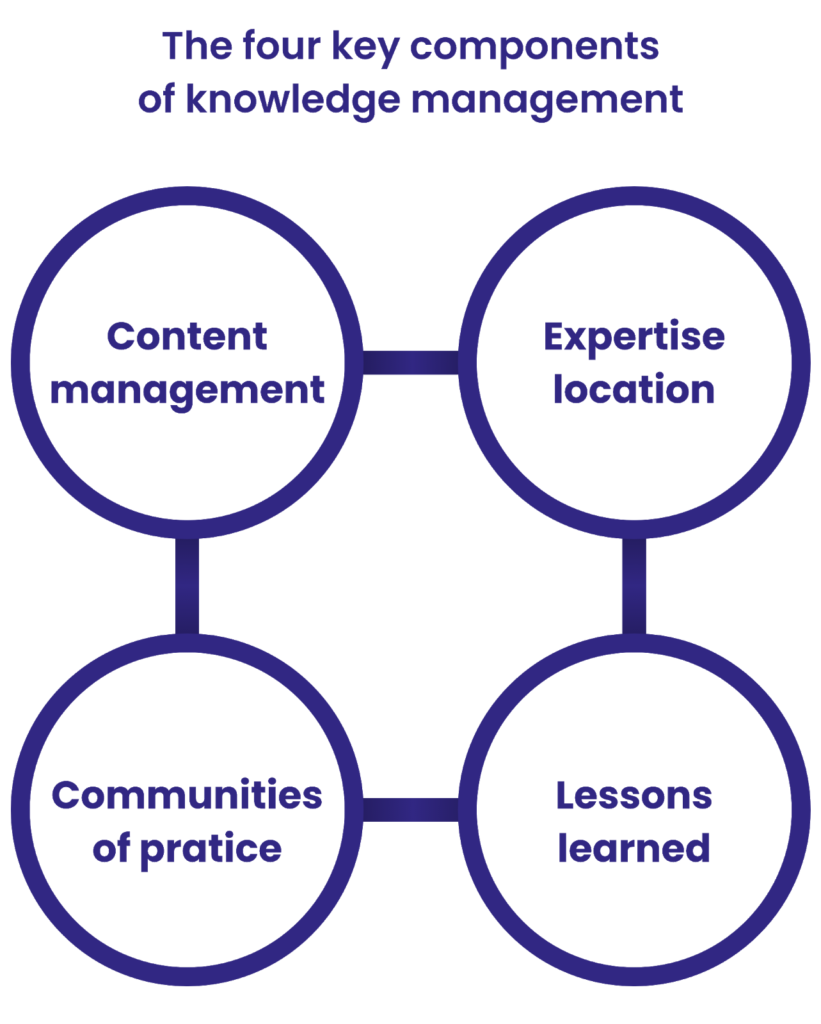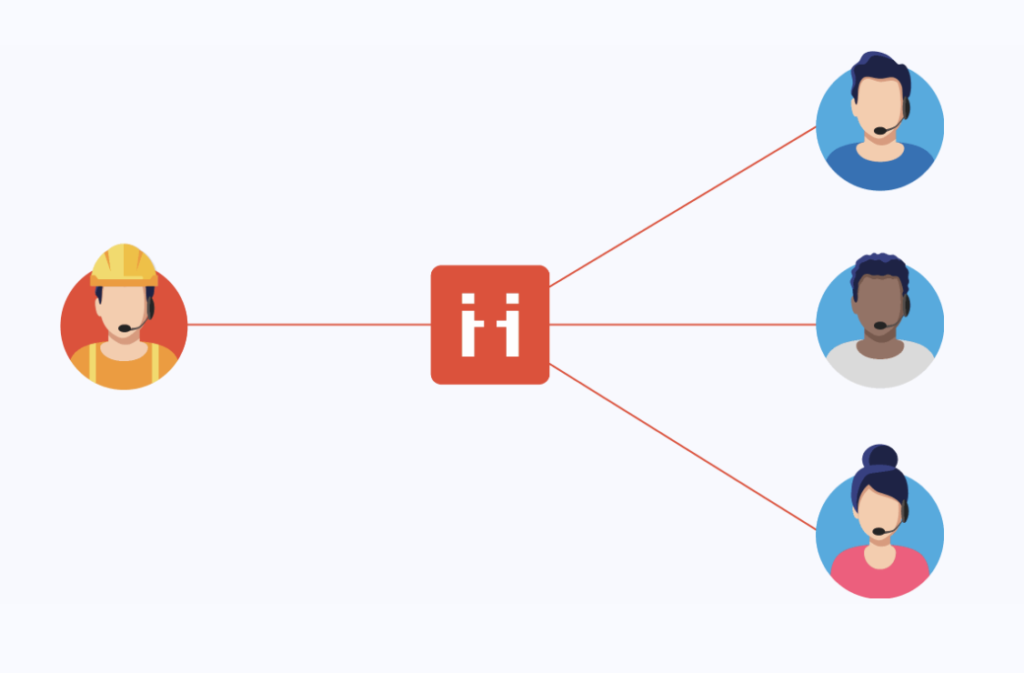
Share this article
Share this article
Knowledge management describes processes that allow organizations to capture and disseminate knowledge. Recently the definition has been expanded to include the sharing of all information assets which includes databases, documents, procedures, and expertise and experience in individual workers.
Knowledge management operationalizes information, turning stagnant knowledge into operational assets and empowers employees by giving the right information to the right person at the right time.
In modern business, knowledge is power. Successful organizations outcompete competitors by having a larger bandwidth of knowledge on everything from operational efficiencies to industry best practices. A recent study sheds light on the importance of knowledge management; 75% of organizations say creating and preserving knowledge across evolving workforces is very important for their success.
Companies have begun to recognize the importance of knowledge but have been slow to adapt. That same study reports that only 9% of organizations surveyed say that they are very ready to address the knowledge management trend, leaving a palpable gap between perceiving and implementing the needed changes. When it comes to proper knowledge management many companies are aware of the benefits and necessity for a knowledge management system, yet are hesitant to take action.
If knowledge is capital, high employee turnover rates represent a massive loss in capital. Sectors with high turnover rates such as the field service industry are currently haemorrhaging knowledge and thus capital without robust solutions.
Most companies rely solely on exit interviews to capture an employees’ knowledge when they leave an organization, however exit interviews take place too late to be able to capture the true depth of any one employee’s knowledge. Knowledge retention strategies should be proactive, going into effect long before a key employee leaves an organization. Taking the necessary steps to build knowledge management solutions to retain expert knowledge is key to an organization’s long term success.
Knowledge management also has important implications for employee training. By sharing archived expert knowledge, novice employees have access to real-world experiences. For example, by watching videos recorded on the job, a technician in training can learn best practices directly from experts and also see how employees make errors which leads to learning opportunities.
Knowledge management solutions accelerate training cycles, further empowering rookie employees while making them operational sooner.
The following four items represent the macroscale components of any successful knowledge management system.

Content management refers to how — whether through portals or dashboards — information is stored by admins and accessed by users. It’s imperative to create a content platform that is easily accessible and simple yet robust in use so that all stakeholders can manage and retrieve data without friction. In fact, 71% of people who considered it easy to access the information also perceived its value as being above average. There’s little point in having a massive repository of information if the content is tedious to access.
Successful organizations will look to accumulate knowledge over time, therefore content management platforms must be scalable. Organizations must plan not only for current needs but future needs. Doing so requires companies to build content management platforms that can accommodate the influx of new and often multimedia information in an organized manner.
There are two primary types of content to manage; internal and external.
Internal content is used for employee empowerment and can take many shapes, from ticket archives to recorded learning experiences. Employees can access this form of content to optimize current practices or to innovate new practices.
External content serves the user and can range from tutorial repositories to scenario solutions. The goal of external content is to both empower the user and to make their experience frictionless. Empowered users are less likely to contact help centers for small fixes, allowing agents to spend time resolving complicated issues.
The main constraint to knowledge management is initially capturing it. Expertise location presents a structured path to locate individuals who possess expert knowledge so that their knowledge can be recorded and disseminated.
The process of finding these experts is twofold.
First, one must understand what type of expertise they are looking for. This can vary depending on business function, for example, a consumer technology company that targets younger demographics may look for younger employees with ties to the target demographic. Conversely, an oil company looking to improve repair times on rigs may seek expert knowledge from older employees with a profound amount of experience working on rigs.
Next, it’s important to construct specific criteria to find employees possessing the requisite knowledge. Criteria may include,
Once the criteria have been established, the search can begin.
This often tedious expert location process can be simplified by call routing technology. ViiBE’s expertise call routing solution enables companies to immediately connect with experts regardless of their location. ViiBE’s internal collaborators have access to a call center that connects them instantly with the right experts through a tag system.
For example, if a construction site technician is experiencing issues with a piece of crane machinery, they can initiate a ViiBE call and use the “call expertise” feature. With this, the technician can select the mechanical expertise tag as well as the call center or region that he or she is calling from. By selecting the tag needed, a call request is sent to every expert that corresponds to the chosen expertise and call center tags. The first expert to answer the call will instantly connect with the technician in need.

Lessons learned refers to information that has been gained through individual experience, rather than from training modules or workshops. Since lessons learned are gained outside the institution, it’s imperative to record them, and integrate them into an accessible knowledge management system. In the future, others can draw from those lessons learned to optimize their work.
Lessons learned can have a large scale impact on an organization’s operations. Take for example a treadmill technician who discovers a shortcut to fix the belt rotator. An individual technician using that shortcut can save half an hour of work. However, if that shortcut is shared and the company’s hundred other technicians use it to optimize their work, hundreds of hours of billable dispatch time will be eliminated. This will ultimately lead to a sharp decrease in field operation costs.
The goal of sharing lessons learned is to make personal experience public, however, in order to do so effectively, the following actions must be placed at the center of an organization’s culture.
Incentivize sharing: Internal competition is a common barrier to knowledge sharing. In order to overcome such barriers, companies should consider restructuring reward systems to incentivize knowledge sharing. According to Deloitte’s 2020 Human Capital Trends study, 37% of respondents reported a lack of incentives as a common barrier to effective knowledge management.
In order to reduce harmful internal competition, companies could consider reducing performance-based bonuses and increasing base salaries which would decrease competition amongst employees in performance-based reward schemes such as field technicians. Companies should also look towards intrinsic motivators such as praise and recognition to spur peer-to-peer collaboration.
Create a collaborative learning culture: There are multiple knowledge pathways within the realm of knowledge management. So far we’ve discussed the person → database pathway in which employees capture and upload specific experiences, however, the person → person pathway is equally important for two reasons.
First, by creating a culture that normalizes person → person knowledge sharing, the likelihood of those same employees feeling comfortable uploading their lessons learned to a database is increased.
Second, expert knowledge may not be recorded and fall through the cracks of an organization. Putting people in collaboration positions is another way to ensure expert knowledge is passed along.
Initiatives that foster collaboration such as,
These initiatives put employees in frequent contact with an array of experts, giving them access to potentially cached information.
Another way to structure a person → person sharing is through communities of practice.

Communities of practice describes groups of people with common passions for something they do and how they learn to do it better as they interact regularly. In smaller or more concentrated organizations, these types of interactions can take place in the lunchroom, in the field, or around the water cooler. However, in larger more spread out organizations, these groups become more structured and often take place virtually.
Examples of communities of practice run the gamut from telecom field technician associations to groups of oil well machine operators. Regardless of their composition, each group has similar goals;
Communities of practice are rich potential sources of helpful information in the form of lessons learned and best practices. Organizing communities will foster perpetual knowledge sharing and operational improvement.
Knowledge management is carving out a niche in the call center and field service industries thanks to its application to ticket tracking solutions. Ticket tracking allows agents to rapidly access case-specific information from past interactions resulting in faster problem resolution times. Ticket tracking is based on a content management system that permits the sharing of information across a platform, giving all agents access to the same repository of information.
The utility of knowledge management in call center operations is vast. Take for example a support agent, using ViiBE, who is unsure how to resolve a customer’s problem. The agent could search within the content management platform for a ticket tag relevant to the customer’s problem (like “bike”) then see the tickets and interactions for past interactions. Then, once the agent has found the necessary information, he or she can use the “call back” function to initiate another call with the same customer.
The knowledge management features of ticket tracking record comprehensive data from calls. Data from call time, to documents shared, to KPIs such as first contact resolution are collected and saved for future reference.
Knowledge management is also being readily applied within the Oil industry. Facing extreme volatility, in 2020 alone one million oilfield jobs were estimated to have been cut. In order to retain expert knowledge companies have been turning to knowledge management solutions such as ViiBE’s ticket tracking solution.
Poorly managed institutional knowledge is like trying to fill a water bucket with holes in the bottom. Water, like knowledge enters, flows through, and then leaves. The need for knowledge management solutions is far from a secret, yet relatively few organizations have implemented solutions.
Establishing a content management system, successfully locating expertise, sharing lessons learned, and empowering communities of practice are key components to any successful knowledge management solution. Ingraining such solutions into the fabric of an organization will be the key to long term success.